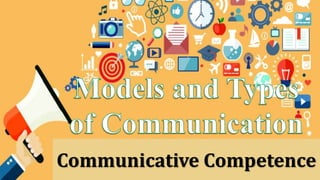
Models and Types of Communication.pptx
- 2. Explore… Communication: Its Meaning, Importance and Models
- 3. What is Communication? • the actionable transfer of information from one person, group, or place to another by writing, speaking, or using a medium that provides a means of understanding. • Every communication consists of a minimum of one sender, a receiver, and a message.
- 4. Verbal Communication • a type of oral communication wherein the message is transmitted through the spoken words. Here the sender gives words to his feelings, thoughts, ideas and opinions and expresses them in the form of speeches, discussions, presentations, and conversations.
- 5. Non-Verbal Communication the transfer of information through body language, facial expressions, gestures, created space and more. For example, smiling when you meet someone conveys friendliness, acceptance and openness.
- 6. Concept of Communication Communication involves transmitting non-verbal and verbal information in a channel that includes: Sender Medium Receiver
- 7. Sender and Receiver The person sending the information and the one receiving the information must be present for communication to be effective.
- 8. The Message The information conveyed should be available for the sender to transmit to the receiver. Communication works when people hear, see, feel, and understand what a sender is trying to convey; this ensures that concentration and attention are given to important details, allowing for the smooth transfer of information.
- 9. The Medium/Channel the means through which the communication passes to reach the recipient. Examples of mediums include mobile phones and television shows, among others.
- 10. Feedback Communication is a give-and-take scenario, and therefore all parties involved must actively ensure that the message is well understand. “Alright, I get your point.” “I understand.”
- 12. Aristotle Model of Communication known as the first model of communication focusing mainly on the speaker and messages.
- 13. Example: A political leader (speaker/sender) delivers a speech to persuade voters to vote for him. The political leader is the most crucial person who provides the message or information. The speech is the leader’s message to influence the voters to vote for him. The election is the occasion, and the speech or message of the speaker is set based on the occasion. Political leaders might not deliver the same kind of speech before and after the election. Finally, the effect refers to the level of motivation of the voters, whether they are motivated to vote for him or not.
- 14. Shannon-Weaver’s Model represents six essential communication elements: information source, transmitter, channel, receiver, destination, and noise source.
- 15. The Importance of Audience and Purpose in Communication People write and communicate differently, depending on the intended recipient. For example, in a personal letter to a friend, you probably use slang, jump from thought to thought, and use creative punctuation. This approach would likely be inappropriate in an essay for a professor. In academic writing, knowing your audience will influence the way that you present material: o Simple audience: If your audience has an academic background similar to yours, you can expect that they are familiar with terms and concepts that you employ. o Multiple audience: If you are writing for a more diverse audience, you need to think about presenting the material to people with differing levels of knowledge about your topic
- 16. Knowing your purpose: Once you have established for whom you write or speak, you must also determine why you write. You have to decide what you want to accomplish: this is your purpose. To reflect on experience To inform others about a subject To change people’s attitudes To persuade your readers to pursue a course of action
- 17. 10 Barriers to Effective Communication
- 18. • “Everything has been said before, but since nobody listens we have to keep going back and beginning all over again.” – André Gide (French author and winner of the Nobel Prize in literature in 1947).
- 19. PHYSICAL BARRIERS this has to do with poor or outdated equipment used during communications, background noise, poor lighting, temperatures that are too hot or too cold.
- 20. ATTITUDES •emotions like anger or sadness can taint objectivity. Also being extremely nervous, having a personal agenda or “needing to be right no matter what” can make communications less than effective. This is also known as “Emotional Noise”.
- 21. LANGUAGE Even people speaking the same language can have difficulty understanding each other if they are from different generations or from different regions of the same country. Slang, professional jargon and regional colloquialisms can even hurt communicators with the best intentions.
- 22. PHYSIOLOGICAL BARRIERS ill health, poor eyesight or hearing difficulties, pain.
- 23. PROBLEMS WITH STRUCTURE DESIGN bad information systems, and lack of supervision or training of the people involved.
- 24. CULTURAL NOISE people sometimes make stereotypical assumptions about others based on their cultural background. - What is polite in one culture may be rude in another culture.
- 25. LACK OF COMMON EXPERIENCE it’s a great idea to use examples or stories to explain a point that is being discussed. However, if the speaker and the audience cannot relate to these examples because they do not have the same knowledge or have not shared the same experiences then this tool will be ineffective.
- 26. AMBIGUITY AND ABSTRACTIONS OVERUSE using too many generalizations, proverbs or sayings, can all lead to communications that are not clear and that can lend themselves to misinterpretations.
- 27. INFORMATION OVERLOAD it takes time to process a lot of information and too many details can overwhelm and distract the audience from the important topics. Keep it Simple.
- 28. ASSUMPTIONS AND JUMPING TO CONCLUSIONS This can make someone reach a decision about something before listening to all the facts.